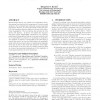Free Online Productivity Tools
i2Speak
i2Symbol
i2OCR
iTex2Img
iWeb2Print
iWeb2Shot
i2Type
iPdf2Split
iPdf2Merge
i2Bopomofo
i2Arabic
i2Style
i2Image
i2PDF
iLatex2Rtf
Sci2ools
COMPGEOM
2010
ACM
2010
ACM
The complexity of the normal surface solution space
Normal surface theory is a central tool in algorithmic threedimensional topology, and the enumeration of vertex normal surfaces is the computational bottleneck in many important algorithms. However, it is not well understood how the number of such surfaces grows in relation to the size of the underlying triangulation. Here we address this problem in both theory and practice. In theory, we tighten the exponential upper bound substantially; furthermore, we construct pathological triangulations that prove an exponential bound to be unavoidable. In practice, we undertake a comprehensive analysis of millions of triangulations and find that in general the number of vertex normal surfaces is remarkably small, with strong evidence that our pathological triangulations may in fact be the worst case scenarios. This analysis is the first of its kind, and the striking behaviour that we observe has important implications for the feasibility of topological algorithms in three dimensions. Categorie...
COMPGEOM 2010 | Discrete Geometry | Normal Surface | Pathological Triangulations | Vertex Normal Surfaces |
| Added | 02 Aug 2010 |
| Updated | 02 Aug 2010 |
| Type | Conference |
| Year | 2010 |
| Where | COMPGEOM |
| Authors | Benjamin A. Burton |
Comments (0)

